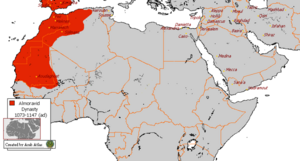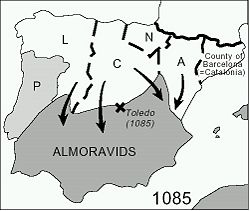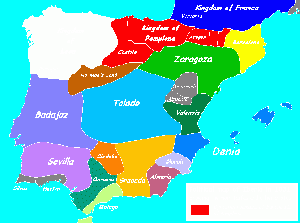Almoravid dynasty
The Almoravids, was a Berber dynasty from the Sahara that spread over a wide area of North-Western Africa and the Iberian peninsula during the eleventh century. They created the first Moroccan and trans-Maghreb empire.[1] They were invited by the Muslim rulers in Iberia to aid them against the Christians. As well as holding back the Christian advance, they overthrew the Muslim princes whom they denounced as religiously lax, thus extending the Moorish empire over present-day Morocco, Western Sahara, Mauritania, Gibraltar, Tlemcen (in Algeria) and a great part of what is now Senegal and Mali in the south, and Spain and Portugal to the north in Europe. At its extent, the empire stretched 3,000 kilometers north to south.
The exact meaning of "Murabit" (from which Almoravid is derived). is a matter of controversy. The name may be derived from the Arabic ribat (meaning tie or fortress (a term with which it shares the root r-b-t). This was the common opinion some time ago, however most historians now believe that it refers to ribat, meaning "tied to Horses" (ready for battle).[2] Having ousted the earlier Muslim rulers in the name of a purer form of Islam, they were themselves ousted by the Almohad Dynasty, who claimed that their interpretation of Islam was even purer. The early Emirs were charismatic and battle-proven, and so they were able to maintain their power. Their heirs, born to rule, may well have been as pious as their ancestors but their authority was inherited rather than gained on the field of battle. Ruling conquered people, they did not have enough support to maintain power. Having promised low taxation and prosperity, in the end they had to raise taxes to fight on two fronts, which they could ill afford. This lost whatever support they had and many of their subjects openly welcomed the Almohads, who "offered a new order" based "on victory rather than defeat" and one that "at least for the moment, better served their wants."[3] The Almoravids are not the only administration or government that has fallen as a result of breaking promises, even though they were compelled to do so in defense of the realm.
Beginnings
The most powerful of the tribes of the Sahara, south of the Draa River to the Sénégal River was the Lamtuna, whose region of origin was 'Wadi Noun' (Nul Lemta). They later spread as far as the upper Niger River region, where they founded the city of Aoudaghost. They had been converted to Islam in the seventeenth century.
Influence of orthodox Islam
About the year 1040 (or a little earlier) one of their chiefs, Yahya ibn Ibrahim, made the pilgrimage to Makkah. On his way home, he attended the teachers of the mosque at Kairouan, in Tunisia, who soon learnt from him that his people knew little of the religion they were supposed to profess. The theologians of Kairawan, one of whom was from Fez, provided Yahya with a missionary, Abdallah ibn Yasin, a devout follower of the Malikis, one of the four legal schools of Sunni Islam.
On returning to his home area, Yahya started to preach that Muslims should follow the teachings of the Quran, and the orthodox tradition or Sunnah. He soon found himself opposed by the Lamtunas and, on the advice of ibn Yasin, retired to Saharan regions where he found a more sympathetic audience. His influence spread. His followers, gathered from a variety of Berber clans, became known as the Almoravids,
Military training
Abd-Allah ibn Yasin imposed a penitential scourging on all converts as a purification, and enforced a regular system of discipline for every breach of the law; even on the chiefs. Under this regime, the Almoravids were transformed into a formidable fighting force. While ibn Yasin acted as spiritual mentor, Yahya was the military and political leader. Their main force was infantry, armed with javelins in the front ranks and pikes behind, which formed into a phalanx; and was supported by camelmen and horsemen on the flanks.
Military successes
From the year 1053, the Almoravids began to spread their reformist teaching to the Berber areas of the Sahara, and to the regions south of the desert. They converted Takrur (a small state in modern Senegal) to Islam, and after winning over the Sanhaja Berber tribe, they quickly took control of the entire desert trade route, seizing Sijilmasa at the northern end in 1054, and Aoudaghost at the southern end in 1055. Yahya ibn Ibrahim was killed in a battle in 1056. Abd-Allah ibn Yasin, whose influence as a religious teacher was paramount, named Yahya's brother Abu-Bakr Ibn-Umar as chief. Under him, the Almoravids soon began to spread their power beyond the desert, and brought the tribes of the Atlas Mountains under their rule. They then came in contact with the Berghouata, a branch of the Zenata of central Morocco, who followed a "heresy" founded by Salih ibn Tarif, three centuries earlier. The Berghouata made a fierce resistance, and Abdullah ibn Yasinin was killed while fighting them. Abu-Bakr Ibn-Umar continued the campaign and defeated them, taking the defeated chief's widow, Zainab, as a wife.
In 1059, Abu-Bakr Ibn-Umar reorganized the administration of his territory, appointing his cousin, Yusuf ibn Tashfin as viceroy over the more-settled parts. He also gave him his favorite wife, the former Queen Zainab (after divorcing her). For himself, he reserved the task of suppressing revolts which had broken out in the desert. In 1060, when he returned to resume control, he found his cousin too powerful to be removed, so instead went back to the Sahara, where, in 1087, following a wound from a poisoned arrow, he died. He is reputed to have spread Islam in the southern Sahara. He may have attacked Ghana in 1076.
Yusuf ibn Tashfin had in the meantime brought what is now known as Morocco, Western Sahara and Mauretania under his rule and in 1062 had built the city of Marrakech as his capital. In 1080, he conquered the kingdom of Tlemcen (in modern-day Algeria) and founded the present city of that Algiers, extending his rule as far east as Oran.
Ghana Empire
In 1075, the Almoravids conquered Ghana Empire. According to Arab tradition, the ensuing war ended the kingdom's position as a commercial and military power by 1100. It collapsed into tribal groups and chieftaincies, some of which later assimilated into the Almoravids while others founded the Mali Empire. The Almoravid religious influence was gradual and not heavily involved in military strife, as Almoravids increased in power by marrying among the nation's nobility.
Iberian Peninsula
In 1086 Yusuf ibn Tashfin was invited by the Muslim princes in the Iberian Peninsula (Al-Andalus) to defend them against Alfonso VI, King of Castile and León. After the collapse of the Umayyads of Cordoba, Muslim Spain had split into small states, or taifa, each under an Emir or Prince. After the Fall of Toledo in 1085, the princes turned to the Maghrib for help. In 1086, Yusuf ibn Tashfin crossed the straits to Algeciras, then inflicted a severe defeat on the Christians at the az-Zallaqah. He was prevented from following up his victory by trouble in Africa, which he had to settle in person. When the princes invited the Almoravids they assumed that they would "help out militarily," then go home. When Yusuf ibn Tashfin returned to the Maghrib, they thought he had done the job he came to do and had left Iberia for good. This proved to be wishful thinking.[4]
Ibn Tashfin had no intention of halting his empire at the straits. As far as he was concerned, the Muslim princes of Iberia were "intolerably weak, with their diplomatic relations with Christian states, not to mention their promotion of Jews in virtually every corner of their government and society."[4] When he returned to Iberia in 1090, it was with the express purpose of deposing the Muslim princes as corrupt, and annexing their states. He gained favor from the mass of inhabitants, who were worn out by the oppressive taxation imposed by their spend-thrift rulers, by promising low taxation. Their religious teachers, as well as others in the east, (most notably, al-Ghazali (Abu-Bakr Ibn-Umar had been his pupil) and al-Tartushi in Egypt, who was himself an Iberian by birth, from Tortosa), detested the native Muslim princes for their religious indifference, and gave Yusuf a fatwa, or legal opinion, to the effect that he had good moral and religious right, to dethrone the rulers. By 1094, he had removed them all, except for Emir of Zaragoza. Although he regained little from the Christians, he re-united the Muslim power, checked the reconquest of the country by the Christians. His only defeat was at the hands of El Cid at Valencia in 1094, although the city finally fell to the Almoravids in 1102.
The Commander of the Muslims
After friendly correspondence with the caliph at Baghdad, whom he acknowledged as Amir al-Mu'minin (Commander of the Faithful), Yusuf ibn Tashfin in 1097 assumed the title of Amir al Muslimin (Commander of the Muslims). He died in 1106, when he was reputed to have reached the age of 101.
The Almoravid power was at its height at Yusuf's death, and the Moorish empire then included all North-West Africa as far as Algiers, and all of Iberia south of the Tagus, with the east coast as far as the mouth of the Ebro, and included the Balearic Islands.
Decline
Three years afterwards, under Yusef's son and successor, Ali ibn Yusuf, Sintra and Santarém were added. The tide, however, was turning against the Muslims in Spain. With French help, the Christians re-took Zaragoza in 1118. In 1138, Ali ibn Yusuf was defeated by Alfonso VII of Castile and León, and in the Battle of Ourique (1139), by Afonso I of Portugal, and Lisbon was recovered by the Portuguese in 1147. The Almoravids ruled as a military elite, enjoying little popular support. They wore a distinctive face-mask, or veil (litham), which easily identified them in the street. A remnant of the desert, they saw this as a symbol of pride but it "made them ominous to their subjects."[1] Towards the end of their rule, they employed Christian guards in Andalusia as well as Christian soldiers elsewhere in their territory, despite having based their case against their predecessors mainly on their tolerance of Christians, whose habits, they said, they had adopted. They failed to integrate "local aristocracies into their ruling system or to form a loyal local bureaucracy." The fuqaha (jurists) whom they employed to administer justice were "not Almoravids: they were opportunists who supported the new regime only to perpetuate their own positions of power." Stricter even than their masters in their interpretation of Maliki law, they were unpopular with the people and also with the local elites, who "felt they were passed over and had never been successfully integrated into the Almoravid hierarchy." When the Almohads rebelled in the Maghrib, the cost of fighting on two fronts also compelled them to "raise taxes" including "non-Qur'anic" taxes which they had vowed they would never levy. Not only did this result in a loss of credibility, it also "proved fatal." They even employed "Christian mercenaries to collect" this revenue. Clancy-Smith says that making promises they could not keep was a major contributing factor behind their fall. When they ousted the Taifa princes, they had promised the Muslims of Andalusia a "better life, security and low taxes." As long as they delivered this, the people endured "austere religious reformism." When they broke their promise, they lost what popularity they had enjoyed, "because they failed to meet the expectations they had created among their own subjects."[1] Menocal refers to civil unrest as early as 1109 caused by their interpretation of Islam; when they burned a book by the famous theologian Al-Ghazali "anti-Almoravid riots broke out in Cordoba." Ghazali's "humane approach to Islam, despite its orthodoxy, was too liberal for the fanatical Almoravids," she says.[4] This seems ironic, since he had supported their Iberian project. However, he later criticized what he saw as their over zealousness and anti-Sufi stance. Ali ibn Yusuf, the third Emir, ordered the burning and made death mandatory for anyone found possessing al-Ghazali's writing.[5]
Ali ibn Yusuf was reputedly pious but did not have the experience, or enjoy the respect, of his father, Yusuf ibn Tashfin and is said to have fasted and prayed while his empire fell to pieces under the combined action of his Christian foes in Iberia and the agitation of Almohads (the Muwahhids) in Morocco. It was during his rule, though, that exchange between Spain and the Maghrib developed to such an extent that not only merchants but also artists and literati regularly crossed between the straits between the two. He surrounded himself with intellectuals.[1]
After Ali ibn Yusuf's death in 1142, his son Tashfin ibn Ali lost ground rapidly before the Almohads, and in 1146 he was killed by a fall from a precipice, while endeavoring to escape after a defeat near Oran. His two successors were Ibrahim ibn Tashfin and Is'haq ibn Ali, but their reign was only short. The conquest of the city of Marrakech by the Almohads in 1147 marked the fall of the dynasty, though fragments of the Almoravids (the Banu Ghaniya), continued to struggle in the Balearic Islands, and finally in Tunisia. As the Almoravid light dimmed, the Almohads may even have been encouraged to enter Iberia to help hold back the Christians, just as the Almoravids had been invited before them.
Legacy
The Almoravids despised the decorative architectural style of their Umayyad predecessors in Spain and did not engage in extensive building activity. What they did build was characteristically puritan in style, with little decoration. Ali ibn Yusuf supported the famous University of Al-Karaouine at Fez. Like the Almohads who succeeded them both in the Maghrib in Iberia, they began as a zealous reforming religious movement that frowned upon moral and spiritual laxity and on collaboration with Christians. Once they had gained an empire, however, their outlook changed. When their survival depended on employing Christian soldiers, they did so. The first emirs, who became leaders more or less on the field of battle, were accomplished soldiers and skilled commanders. However, their successors, born to rule, though perhaps equally pious lacked the skill needed to stem the tide of revolt. What began as a type of charismatic leadership was later routinized into a hereditary dynasty that lost its vitality. Lacking local support, it was their need to increase taxation, too, that motivated many to switch their loyalty to the Almohads. The Almohads began in a remarkably similar way, also tracing their origin to a pilgrim who traveled to Mecca, then spent time at a Religious Academy and began to preach a reformist message upon returning home. The reforming Almoravids, in the end, were ousted by other revivalists, who claimed that their Islam was purerâcloser to the Islam of Muhammad, for which in their view the Almoravids had substituted scholastic theology. It was not so much that they became corrupt but rather that they "failed to fully make the transition from pastoral-nomad culture to city civilization and therein lay the fundamental cause of their overthrow; they remained too deeply rooted in the desert ethos ... to successfully meet the Almohad challenge."[1] They failed to adjust to life in Spain.
Family names such as Morabito, Murabito and Mirabito are common in western Sicily, the Aeolian Islands and southern Calabria in Italy. These names may have appeared in this region as early as the eleventh century, when Robert Guiscard and the Normans defeated the Saracens (Muslims) in Sicily. In addition to southern Italy, there are also sizable populations of Mourabit (also spelled Morabit or Murabit) in modern-day Morocco, Tunisia and Mauritania.
Emirs
- Abdallah Ibn Yasin (1040-1059)
- Yusuf ibn Tashfin (1061â1106)
- Ali ibn Yusuf (1106â42)
- Tashfin ibn Ali (1142â46)
- Ibrahim ibn Tashfin (1146)
- Ishaq ibn Ali (1146â47)
Notes
- â 1.0 1.1 1.2 1.3 1.4 Julia Ann Clancy-Smith, North Africa, Islam, and the Mediterranean world: from the Almoravids to the Algerian War. Cass seriesâhistory and society in the Islamic world (London, UK: Frank Cass, 2001, ISBN 9780714651705), 32.
- â Clancy-Smith, 76N3.
- â Clancy-Smith, 74.
- â 4.0 4.1 4.2 Maria Rosa Menocal, The Ornament of the World: how Muslims, Jews, and Christians Created a Culture of Tolerance in Medieval Spain (New York, NY: Little, Brown & Co., 2002, ISBN 0316168718), 43.
- â Sandereson Beck, Africa to 1500 San.Beck.org, 2004. Retrieved May 11, 2008.
ReferencesISBN links support NWE through referral fees
- This article incorporates text from the Encyclopædia Britannica Eleventh Edition, a publication now in the public domain.
- Chejne, Anwar G. 1974. Muslim Spain, its history and culture. Minneapolis, MN: University of Minnesota Press. ISBN 9780816606887
- Hrbek, Ivan and Jean Devisse. 1988. "The Almoravids" (336-366) in Muḥammad FÄsÄ« and Ivan Hrbek. General history of Africa. 3, Africa from the seventh to the eleventh century. London, UK: Heinemann Educational Books. ISBN 9780520039148
- Kennedy, Hugh. 1996. Muslim Spain and Portugal: a political history of al-Andalus. London, UK: Longman. ISBN 9780582495159
External links
All links retrieved July 23, 2023.
Credits
New World Encyclopedia writers and editors rewrote and completed the Wikipedia article in accordance with New World Encyclopedia standards. This article abides by terms of the Creative Commons CC-by-sa 3.0 License (CC-by-sa), which may be used and disseminated with proper attribution. Credit is due under the terms of this license that can reference both the New World Encyclopedia contributors and the selfless volunteer contributors of the Wikimedia Foundation. To cite this article click here for a list of acceptable citing formats.The history of earlier contributions by wikipedians is accessible to researchers here:
The history of this article since it was imported to New World Encyclopedia:
Note: Some restrictions may apply to use of individual images which are separately licensed.


